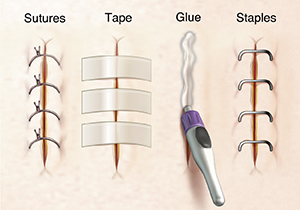Caring for Your Child’s Incision
You’ll need to help care for your child’s incision after surgery and certain medical procedures. To close an incision, your child’s health care provider used stitches (sutures), special strips of surgical tape, surgical staples, or surgical skin glue. Follow the tips on this sheet to help stop bleeding, speed healing, and prevent infection of your child’s incision.
Types of incision closures
-
Surgical stitches. These are placed by sewing the edges of an incision together with surgical thread. Stitches are either absorbable or nonabsorbable. Absorbable stitches break down in the body over time. Nonabsorbable stitches need to be removed by the health care provider.
-
Surgical tape. This is made of sticky (adhesive) material to help hold the edges of an incision together.
-
Surgical staples. These are made of steel or titanium. They are often used to close shallow incisions. They are not used on certain body areas, such as the face and hands. This is because these areas have nerves that are close to the surface.
-
Skin glue. This is a special liquid glue that forms a strong bond between the tissues of an incision or cut (laceration). Skin glue is used to close minor incisions or cuts. It keeps moisture and bacteria from getting into the cut or incision.

Home care
-
Always wash your hands before touching your child's incision.
-
Keep your child's incision clean, dry, and out of water. Tell an older child to keep the incision out of water.
-
Tell your child not to pick at the scabs. Scabs help protect the wound.
-
Your child should take a sponge bath to prevent getting the incision wet, unless the health care provider tells you otherwise. It’s OK to wash around the incision. But don’t spray water right on it.
-
Pat stitches dry if they get wet. Don't rub.
-
Check the incision site daily for pain, redness, drainage, swelling, or separation of the incision edges.
-
If your child has a bandage over the incision, leave it in place until you are told to remove it or change it. Using clean hands, change the bandage as directed by your child’s provider. Always wash your hands before changing your child's bandage.
-
Make sure any clothing that touches the incision is loose-fitting. This will prevent rubbing. If the incision is on the head, keep your child from wearing caps or other head coverings. These may rub against the incision.
-
Keep your child from rough play, contact sports, or physical activities. This can put your child at risk of opening the incision.
-
Make sure your child doesn't do things that could let dirt or sweat get in or on the incision.
-
As your child’s incision heals, the skin may look pink or red. It may also feel slightly bumpy or raised. This is called a healing ridge. Over time, the color should fade and the raised skin will become less noticeable.
Care for specific closures
Follow these guidelines unless your child's health care provider tells you otherwise:
-
Stitches or staples. Once your child no longer needs to keep these dry, clean the incision or wound daily. First remove the bandage using clean hands. Then wash the area gently with soap and warm water. Use a wet cotton swab to loosen and remove any blood or crust that forms. After cleaning, put a thin layer of antibiotic ointment on if your child's provider instructed you to do so. Then put on a new bandage.
-
Skin glue. Don’t put liquid, ointment, or cream on your child's incision or wound while the glue is in place. Don't do activities that cause heavy sweating. Protect the incision or wound from sunlight. Don't scratch, rub, or pick at the glue. Don't put tape right over the glue. The glue should peel off in 5 to 10 days.
-
Surgical tape. Keep your child's incision or wound dry. If it gets wet, blot the area dry with a clean towel. Surgical tape often falls off on its own in 7 to 10 days. If it has not fallen off after 10 days, contact your child's provider before taking it off yourself. If you are told to remove the tape, put mineral oil or petroleum jelly on a cotton ball. Gently rub the tape until it's removed.
Follow-up care
Follow up with your child's health care provider to ask how long stitches or staples should be left in place. Return to have stitches or staples removed as directed. If dissolving stitches were used in your child's mouth, these won't need to be removed. They should fall out or dissolve on their own.
If tape closures were used, remove them yourself when your child's provider tells you to if they have not fallen off on their own. If skin glue was used to close your child's incision, the glue will wear off by itself.
When to contact the doctor
Call your child's health care provider or seek medical care right away if your child has:
-
More pain, redness, swelling, bleeding, or bad-smelling discharge around the incision area.
-
A fever of 100.4°F ( 38°C) or higher, or as directed by the provider.
-
Shaking chills.
-
Vomiting or nausea that doesn’t go away.
-
Numbness, coldness, or tingling around the incision area, or changes in skin color.
-
Stitches or a wound that is opening.
-
Stitches or staples that come apart or fall out, or surgical tape that falls off before 7 days, or as directed by the provider.